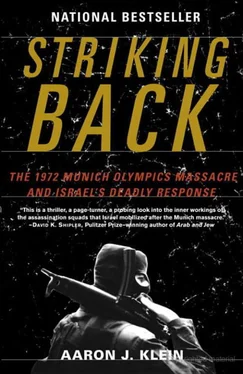Sixteen commandos from Sayeret Matkal, dressed as El Al mechanics in white jumpsuits, approached the plane. They gathered near the emergency exits of the aircraft and along the wings and, in a synchronized assault, burst inside. They immediately killed the two male hijackers and apprehended the two females, inadvertently killing one hostage in the process. The Israeli commandos had taken control of the plane in ninety seconds. The astonishing operation, the first of its kind, soon echoed around the world. A wave of pride washed over Israel. Israeli ingenuity, many felt, could conquer all.
That feeling didn’t change, even though three weeks after the Sabena mission a devastating attack occurred at Israel’s Lod Airport. Three men, members of the Japanese Red Army, a Marxist terrorist group, had volunteered to act under the auspices of the left-wing terror organization the Popular Front for the Liberation of Palestine (PFLP), and carry out the attack. Their goal: to murder as many people as possible, thereby garnering maximum worldwide exposure. They arrived in Israel on an Air France flight from Paris. They went through passport control, claimed their bags, and withdrew AK-47 assault rifles and grenades. Then they opened fire and lobbed hand grenades at the dense crowd waiting nearby. In the chaos that ensued, two of the attackers were killed, probably by one of their own grenades. The third terrorist, Kozo Okamoto, fled. He made it to the tarmac and was captured alive. (He would be sentenced to life behind bars, but was released fourteen years later as part of a prisoner exchange.) Okamoto and his accomplices killed twenty-four people and injured seventy-two. Several of the victims were Puerto Rican pilgrims.
• • •
As the pitiless campaign waged by Palestinian terrorists against the state of Israel unfolded, it exerted a far-reaching influence on the development of terrorism worldwide. International terrorist organizations such as the Japanese Red Army, Baader-Meinhof, and the Armenian ASALA watched and learned as the Palestinians expanded the repertoire of murder, attempting previously undreamt-of missions. And the Palestinian mastery of terror’s twin purposes—propaganda and fear—helped lodge their stateless predicament in the minds of world leaders.
But the worst was yet to come. The failure of the Sabena hijacking increased the resolve of Black September’s leadership. They were determined to pull off an unprecedented, earthshaking attack—a theater of terror that would burn itself into the world’s collective consciousness for generations. They chose the Munich Olympics, to be held in August and September of 1972, as their grand stage.
ISRAEL WINGATE INSTITUTE
JULY 11, 1972
Shmuel Lalkin, head of the Israeli Olympic Delegation, signed the letter, sealed it in an envelope, and dropped it in the outgoing mail pile.
Security and anti-terror precautions were not part of his job description, but they were important to the former Israeli Defense Forces major. Lalkin stuck out in a crowd: he was tall, forty-five years old, had broad shoulders and an athletic bounce to his step, a remnant of his days as a basketball and volleyball player. His hair was swept back and his mustache, a trademark of sorts, was always in perfect order. At first glance he seemed hard, unapproachable. But to those close to him, he was an easygoing family man, a sports lover who was always quick with a smile.
Lalkin slid back in his chair and looked at the envelope. The official letter was addressed to the chief security officer of the Education, Culture and Sports Ministry in Jerusalem. In it, Lalkin, a man who had paid attention to details his entire life, had carefully laid out all his concerns about the security arrangements for the 20th Olympic Games, to be held in six weeks’ time, in Munich, West Germany. Chief among them, Lalkin emphasized how dangerous it was to place the Israeli team on the ground floor of a dormitory in Munich, accessible to all. He assumed German authorities were handling Olympic security, which made the obvious breach all the more egregious.
Three weeks earlier Lalkin had returned from a seven-day visit to northern Munich, where the finishing touches were being put on the new Olympic Village. While he was there, he inspected the arenas, courts, athletic facilities, and dorms his Olympians would use. Other delegation heads were doing the same. In his notebook Lalkin sketched each and every facility the delegation might need. He planned to relay all relevant information to the athletes and coaches before they took off for Munich, as this would help prepare them for the competitions to come. He recognized the psychological importance of familiarity, the edge, however small, it might grant his athletes. Appraising security arrangements was far from his mind.
His priorities shifted when Walter Troeger, mayor of the Olympic Village, gave him a tour of the Israeli dorms at 31 Connollystrasse. The ground-floor location, insecure, vulnerable, made him uncomfortable. In Lalkin’s mind there was simply no defensible logic to support the decision to place the Israelis at street level. He asked to meet with an Olympic security official. West German representatives from the International Olympic Committee were quick to arrange a meeting with an officer named Ruprecht from the Munich police department. Lalkin explained that he bore no official security position but that certain points had come to light and he wished to review some of the security precautions in place for the Israeli delegation. Ruprecht listened in silence. When Lalkin was through, Ruprecht attempted to ease his mind, telling him that he would put the Israeli dorms under tighter security and heavier surveillance. Lalkin wasn’t satisfied. He asked whether the Israeli athletes could be moved to a more secure building, with higher floors, where the entrances could be properly supervised. “Sir,” Ruprecht responded, “I don’t think it’s any of your business. All our decisions concerning your delegation’s living quarters have been coordinated with your embassy’s security people and the Israeli Olympic Committee. Our decisions were made together.” Lalkin left the room in silence, hanging his head.
Back in Israel Lalkin was unsure how to act. The security issues continued to gnaw at him; his sleep was fitful. Eventually, he decided to call two friends, men he’d known in the pre-state Pal-mach fighting unit and later in the IDF, and who were now members of the Shabak. They directed him to Arie Shumar, the Education, Culture and Sports Ministry’s chief security officer. It was Shumar to whom Lalkin sent his official letter, outlining his concerns. “I didn’t feel comfortable with the security arrangements for our athletes. It was important to me to let people know that I thought things should be done differently,” he would later tell the prime minister’s official investigative committee, whose top secret report was made public for the first time as a result of the research for this book. In their findings, known as the Kopel Report, the three-member committee found that several Israeli officials had been given the opportunity to choose the location of the team’s dorms, perhaps in an area easily supervised or on one of the top floors, but hadn’t done so. Not one Israeli official, and many were contacted, asked to change the Israeli location in the village.
The response to Lalkin’s letter came in a plain brown envelope. “Dear Mr. Lalkin: As Manager of the Israeli Olympic team it would be advisable for you to concentrate on sports. Leave security to the security personnel. Yours Truly, Arie Shumar, Chief Security Officer, Education, Culture and Sports Ministry.” The few, arrogant lines ignored Lalkin’s warnings. He had a premonition, he knew the Israeli athletes were at risk, but it wasn’t enough to change the thinking of the entire defense establishment.
Читать дальше












